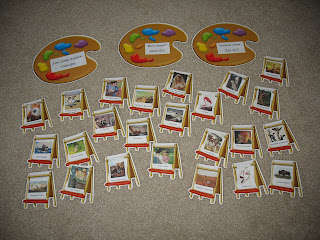So, finally I am back in business with my own computer, so I am now able to focus on a few things, and answering the second part of Kelly's question is one of those.
Kelly asked:
I also was wondering the time commitment with "coming up" with the boxes and activities. With my 19mo. old we are going all the time and makes time management a HUGE thing at our house. I really want to try to start incorporating workboxes with our classical style. Do you think that will work?
This is a toughy really because I cannot see what really goes on in your home. But I once was there with a toddler, preschooler and 2 elementary children-with a husband whose job had him (and still does) on the road more often than not-so believe me when I say, I "understand"-because I do.
I suggest first off, that you decide what exactly you want the children to accomplish each day, for the week and month. Then break that down into what you feel you can handle per day. That should give you an idea of how much material, and planning you have to aim in organizing and carrying out. [time commitment? depends on how many students you have, and the projects you are trying to cover. Even 15-30 per day of prep time is sufficient. If you keep a note pad by your side to jot down stuff you want in the workboxes-whilst doing other things-you won't notice any real time commitment at all]. Not knowing your other children's ages too-makes this somewhat a "shot in the dark" but I will do my best to give you hope and ideas to try.
Once you get into your workbox flow-you could conceivably fill a set of boxes in less than 15 mins-BUT (and this a big one) you have to have your prep work done [again time depends on your particular curriculum and student load-this can range from a several hours spread throughout the week to only a few]. So that is going to require some assistance from dad, granny or a mother's helper. Once per week, with you goal list in hand-figure out what things need to be copied off, items collected, books gathered, and so forth. Take your prep time and get those together and then file them accordingly. I place pre-printed lapbook material, notebook pages and such in file folders in a large file box. Then as the week progresses-I simply pull the needed item and toss into the box. This is a HUGE time saver in the long run. IT takes you getting yourself into the habit of doing this-and it can be a bother from time to time...but the effort spent putting forth direct focus on prep time, will bless you in the end with "quick as a wink" workbox filling. I actually put a lot of time in this past summer getting several things pre-done (seriously, if I could print, cut, organize and get it done-it was done)...the dedication has allowed me to stay the course through unplanned vacations, illnesses and a divulge of "unplanned" situations that have done their best to knock us off course. You may have less work depending on what you use. I honestly cannot give a time frame-some but not so much that you drown. I also know that once I got into my flow, I found I could move quickly from task to task and get the materials and boxes done in short order. So practice makes perfect!
Now, I understand many families who use a particular curriculum or method have decided to only have boxes for each child-that they can do on their own, while keeping the first part of the day (or times throughout the day) to work on group items/projects together. That is a wonderful way to provide the much needed family time (which means toddler can sit right there with you and learn too) and then perhaps when baby goes down for nap (I hope you have that pleasure of a napper) you can focus on more one on one with the older children. So only fill those boxes that are individual to each student-so probably not more than 6. Esp. if the child is 7 and younger. I do not advocate having the youngers doing long, drawn out work at those early ages.
Step into it slowly. Perhaps only having 3 boxes per child with 2 reg. subjects and one with a fun, activity/craft project/game/puzzle, etc. Once the children (and you) get into the flow, slowly add a couple more until you find your perfect wkbx number.
I know I haven't exactly answered your question-as I stated before, I don't think I honestly can. But generally speaking this is a good rule of thumb here: start small, with a couple per child-mainly on their individual type work. Have one set for baby; and allow some time somewhere in the week to put forth focused thought on your goals for that week only.
HTH
I hope this helps. I suggest reading through the other blogs out there to glean more ideas, and thoughts regarding prep time and introducing your family to workboxing.
Also-create workboxes for the toddler to keep the busyness down. I read recently that someone created a box for each day and the child may only do/play with those items on that day-period. That is genius! By keeping those toys/activities for just that day, one alleviates boredom, and provides mother with a much needed "break" to address the other children.
YES, workboxes can be used, but you will have to tweak it to fit your current needs. Do not expect to do the level of wkbx activities, and individual time like I have (as my youngest is 9 and I am currently not watching my preschool aged nephew). If your toddler is more content in the morning then strive to school then (the main stuff) and allow for a quiet time with the others where they need the help for the afternoon.






 \
\ 




























